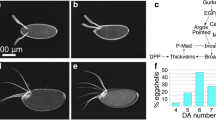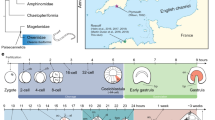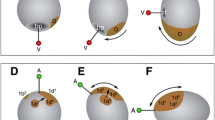Abstract
Embryogenesis in the beetle Tribolium is of increasing interest to both molecular and evolutionary biology because it differs from the Drosophila paradigm by its type of segment specification (short- vs. long-germ) and by the extensive epithelial envelopes – amnion and serosa – that are typical of most insects but not of higher dipterans. Using scanning electron microscopy of DAPI staged embryos we document development in Tribolium castaneum from blastoderm to completion of the envelopes, recording many details not otherwise accessible; we also provide a time table of the respective stages at 30°C. The nascent blastoderm cells remain basally confluent with the yolksac until after the 13th (=last synchronous) mitotic cycle. The cells in the prospective serosa – the first domain to segregate visibly from the uniform blastoderm – carry surface protrusions likely to contact the overlying vitelline envelope. The embryonic rudiment, the other (and larger) blastodermal domain, gives rise to amnion and germ anlage. In the latter, visible differentiation begins with a ”primitive pit” reminiscent of the posterior midgut rudiment of Drosophila. The subsequent invagination of the mesoderm resembles Drosophila gastrulation, except in the head region where the median groove extends through the entire preoral region. The prospective amnion starts differing visibly from the germ anlage during early gastrulation. It then folds underneath the spreading serosa and, advancing with the latter, closes the amniotic cavity at the ventral face of the germband. The largest (=posterior) amniotic fold covers a crestlike protrusion of the yolksac. Together with marked changes in the shape and arrangement of the amnion cells, this protrusion may contribute to the fold’s elevation and early progress.
Similar content being viewed by others
Author information
Authors and Affiliations
Additional information
Received: 12 August 1999 / Accepted: 4 November 1999
Rights and permissions
About this article
Cite this article
Handel, K., Grünfelder, C., Roth, S. et al. Tribolium embryogenesis: a SEM study of cell shapes and movements from blastoderm to serosal closure. Dev Gene Evol 210, 167–179 (2000). https://doi.org/10.1007/s004270050301
Issue Date:
DOI: https://doi.org/10.1007/s004270050301




